What do manors, mining and the G7 all have in common?
The G7 conference was held recently in Carbis Bay, Cornwall. Carbis Bay sits historically within the manor of Trembethow and borders the manors of St Ives and Treloyhan and Lelant and Trevethoe. The area was known for prosperous mining during the 18th and 19th centuries and could quite possibly be the most significant industry in Cornwall’s history; even today the area is surrounded by remnants of old mine workings.
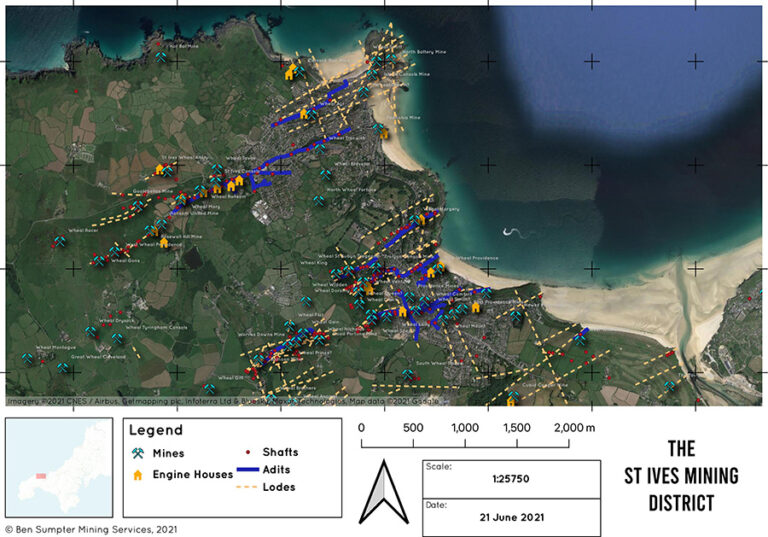
Carbis Bay, St Ives
To the Victorian traveller, a scene of utmost desolation and rude industry would have presented itself, as back then Carbis Bay was largely rural. Billowing plumes of smoke would have issued from the dozen or so engine houses which once worked this barren landscape, and the general cries and communications of workmen would have echoed across the neighbourhood – imagine something out of a scene from ‘Poldark’. In fact, Carbis Bay was home to the BBC crew of the original ‘Poldark’ filmed in the 1970s[ref]Winston Graham, Poldark’s Cornwall, (1983).[/ref].
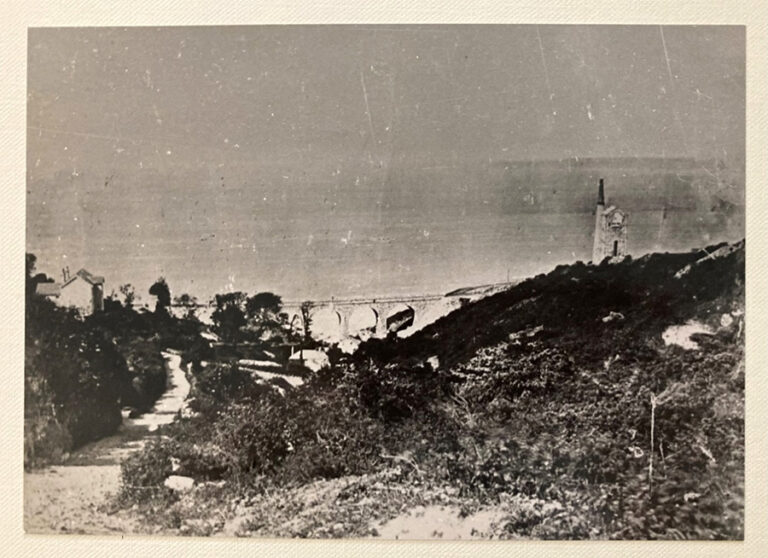
Manor of Trembethow
The manor of Trembethow belonged to the De Als (Hals) family after the Norman Conquest and its ownership has changed many hands, including the Godolphins and Mohuns during the reign of Queen Elizabeth I.
In 1824, when the plan of lands below was drawn, the manor was held in severalties: 1/3, property of William Praed esq; 1/3, executors for Arthur Champernowne esq of Dartington, deceased; remaining 1/3 between Samuel Stephens esq, Rev. Henry Hawkins Tremayne & Francis Hearle Rodd esq[ref]Survey of the lands of Humphry Mackworth Praed, 1792. Catalogue ref: GHW/P/57, Kresen Kernow.[/ref]. The lands of Carninney, Fuggoe and Carbence (Carbis) were all within the manor, while the lands of Chyangweale were part of the bordering manor of St Ives and Treloyhan.
The plan demonstrates how relatively rural the area was, yet the mineral lodes documented provide an indication of just how rich the area was for tin and copper mining.
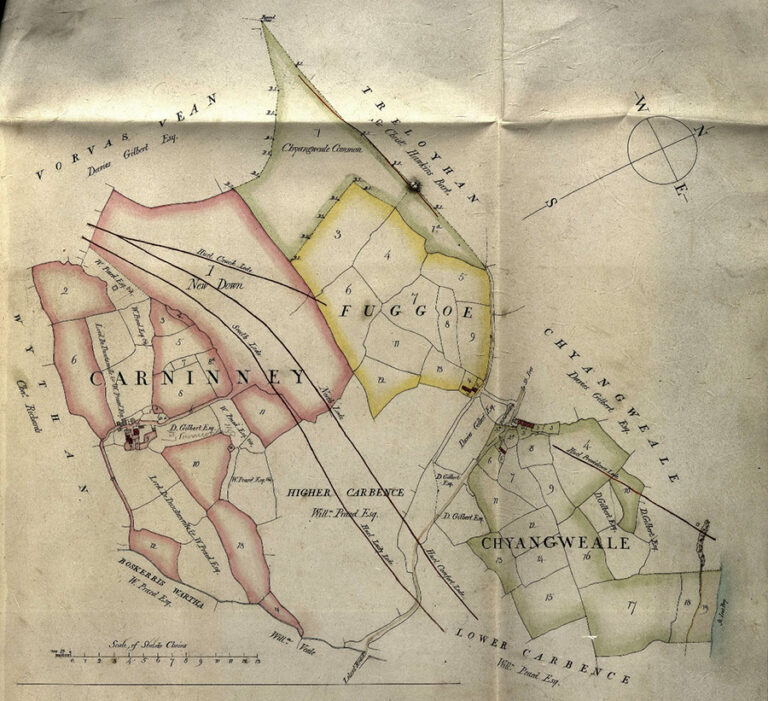
Wheal Margery – Carbis Bay’s most impressive mine
Wheal Margery’s workings date back to at least the 1740s (which is early for underground mining in hard rock) and continued until the 1880s. The mine was originally worked for tin from the surface down by sinking frequent narrow shafts and removing the ore in narrow galleries or ‘stopes’[ref]Allen Buckley, The Story of Mining in Cornwall, (2005).[/ref]. Later workings grew deeper in search of copper and even went beneath the very seabed. Today it is possible to enter the mine’s workings near Knill’s Monument at the top of Carbis Bay and exit through the sea level adit (a tunnel used to drain water from the mine) of Wheal Margery, having crawled and abseiled your way right beneath the main St Ives road and the Treloyhan Manor House.
This surface and underground plan shows Wheal Margery in the middle of the 19th century and depicts clearly how much of the surface ground had been laid to waste through previous mining by this stage. The document shows the many criss-crossing mineral veins, or lodes, in red and also details of the legal boundaries in which a licence, known as a sett, had been granted to mine. The surveyor, a Henry St Aubyn, appears to share a name with one of the mines itself, and perhaps held an interest.
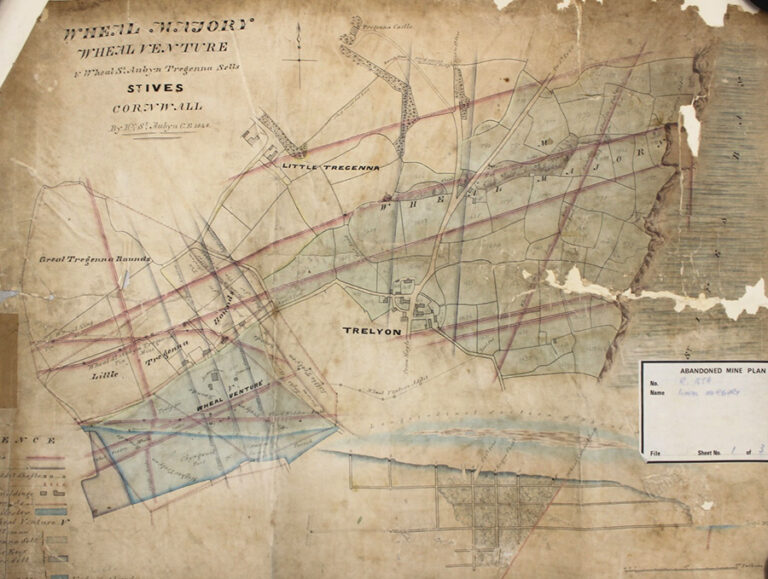
Manor of St Ives and Treloyhan
The manor of St Ives and Treloyhan was held in severalties and bordered the manor of Trembethow. In around 1807, part of the manor within St Ives was conveyed by William and James Backwell Praed to Sir Christopher Hawkins. Hawkins, a considerable landowner, consistently purchased land to gain possession of rotten boroughs and found himself accused of bribery following the 1806 Penryn election. Trialled at Bodmin Assizes and acquitted, he still managed a duel with Lord de Dunstanville! Hawkins also had numerous mining assets around St Ives and opened St Ives Consols in 1818 and was a partner in Cornish Copper Company.
Hawkins died in 1829 and his will was disputed, which resulted in the sale of the St Ives part of the manor to John Hinde in 1830 to pay off debts. The manor was then later sold to William Pole Tylney Long Wellesley (4th Earl of Mornington) and was still held by the family at the time of death of Christian Arthur Wellesley, the 4th Earl Cowley, in 1962[ref]Estate records of St Ives, property of Earls of Mornington and Cowley, (1611-1929). Catalogue ref: X688, Kresen Kernow.[/ref].
The map below is an extract of a larger survey of Sir Christopher Hawkins’ interests in the Manors of St Ives and Treloyhan. Surveyed initially in 1824 by Charles Moody, this later version covers the same area as previously depicted in the map of the Wheal Margery mine by H St. Aubyn and shows the devastation around Wheal Margery Lode, in stark comparison to the otherwise arable land surrounding it.
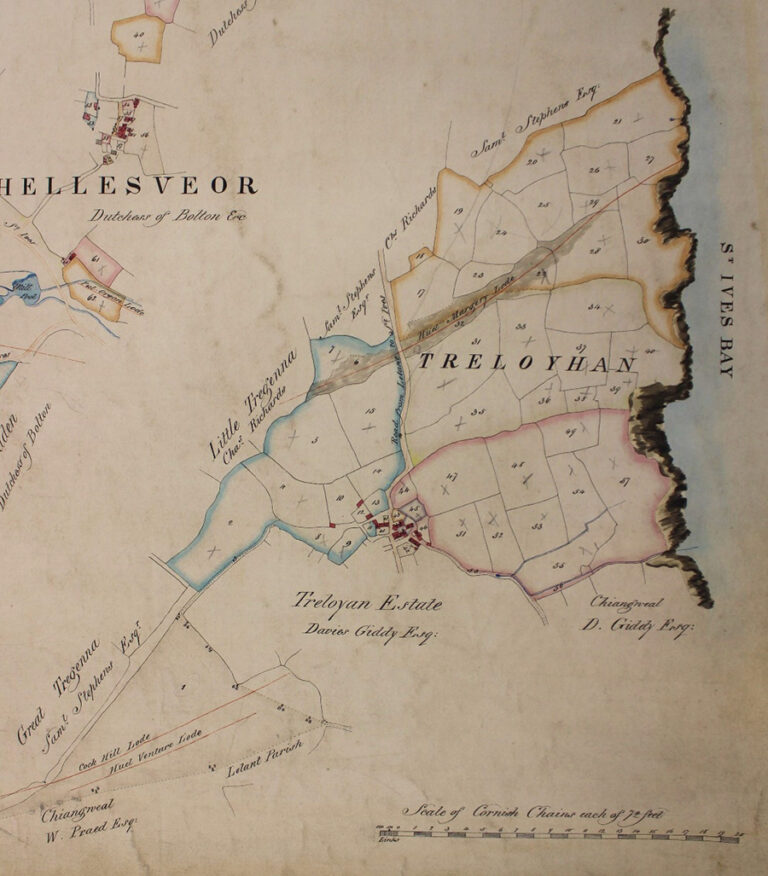
St Ives Mining District
The riches of the mining district were not confined to just St Ives and Carbis Bay; an equally if not even more prosperous area of tin and copper mines also existed inland. The greatest being that of the Wheal Sisters group, saddling the hills of Trink and Trencrom.
Apart from being host to an already highly mature mining industry by the reign of Henry VIII[ref]Allen Buckley, The Tutor Tin Industry, (2009).[/ref], the district was renowned for its plethora of small-scale private ventures, which often survive in the names of mineral lodes recorded on later maps[ref]A K Hamilton Jenkin, Mines and Miners of Cornwall, Vol.1: Around St Ives, (1961).[/ref]. To the north of the district were Giew mine and Wheal Reeth, both worked extensively by the St Ives Consolidated Mining Company in the early 20th century. Turning south, there was the short-lived but well-celebrated Praed Consols, coined in recognition of its mineral lords who had rebuilt and enlarged Trevethow House to grand proportions at the end of the 18th century on account of mining profits.
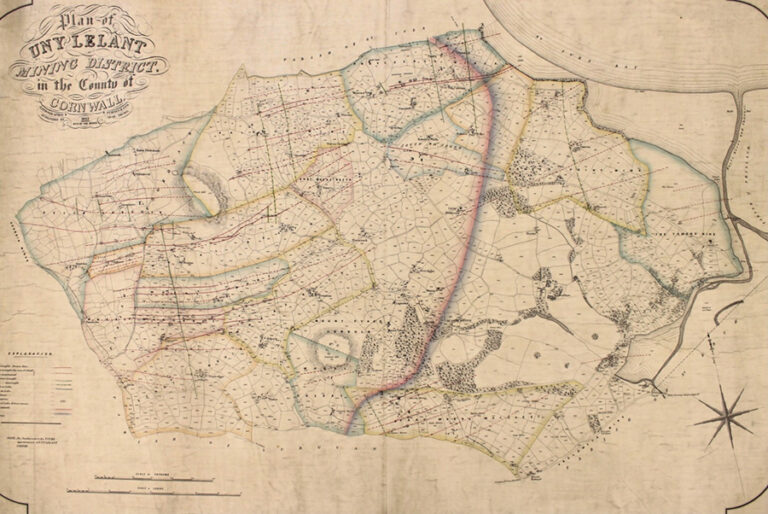
Manor of Lelant and Trevethoe (Trevethow) – Tracing the descent
The early origins of this manor can be traced to around the 1200s, when the land was in the ownership of the Bottreaux family. In the 1400s, with the male line extinct, the family estate was passed to successive female heir Mary Hungerford, Baroness Boteuax, who married Sir Edward Hastings. Hastings was given the peerage of Earl of Huntingdon by Henry VIII and the manor was later sold in part by the Earls of Huntingdon.
We can next trace part of the manor to the Earl of Bedford in 1560, and by 1583 half the manor was sold to the Robartes family of Lanhydrock; it was still in their possession in circa 1656 when John, 2nd Baron Robartes, later the Earl of Radnor, held part of the manor.
In 1749, Mary Vere Robartes sold her part of the manor to John Stephens, esq of St Ives. A survey dated 1752 (shown below) divides the land between three parties: Stephens, Praed and Curnow. An earlier account of rents dated 1678-1701 for the Praed family includes the manor[ref]Accounts of rents due and received, whole estate, (1678-1701). Catalogue ref: GHW/P/52, Kresen Kernow.[/ref].
In the mid-1770s, the manor by descent was in the hands of Humphry Mackworth-Praed, esq. William Praed, esq married Miss Backwell of Tyringham and the manor passed by descent to William Backwell-Tyringham, esq. In 1939, Roger William Gifford Tyringham, esq was noted as lord of the manor.
The Praeds, and later the Tyringhams, certainly owed much of their wealth throughout the 18th and 19th centuries to their mining interests. Two mines in the district reflect this better than perhaps anything else could, by taking their very names: Wheal Tyringham on the southern slopes of Rosewall Hill, and Praed Consols, in a similar position as the former but on Trencrom Hill.
Today, these once bustling industrial communities are very much silent and the country has been designated an Area of Outstanding Natural Beauty (AONB)[ref]Cornwall AONB Map – The Cornwall Area of Outstanding Natural Beauty (cornwall-aonb.gov.uk), (Accessed June 2021).[/ref]. Much archaeology besides the district’s mining heritage is also to be seen, such as the pre-historic embankments and burial remains of Trencrom Hill. These may have given Trevethow its name, given that Trevethow roughly translates to the ‘place of graves’ in Cornish[ref]John Bannister, Glossary of Cornish Place Names, (1871).[/ref].
Below is an example the Praed family’s record-keeping of their estate interests; the book is a copy, in exquisite 18th century hand, of various deeds and conveyances and it records the interest acquired or exchanged for each of the parties. If land was business, manors were run much like companies today, with lords and ladies as shareholders or interested parties. The fortunes of many families relied on land and, with the changes to the Land Tax Act in 1914, the old ways of manorial income ceased to be sustainable. Many of the great landed estates in Cornwall were sold about this time, with the Tyringhams selling some 6,000 acres of freehold by public auction in 1920[ref]Conditions of sale, Trevethoe Estate, Lelant, Towednack and St Erth, (1920). Catalogue ref: GHW/16/V/3/3, Kresen Kernow.[/ref], although the mineral rights were reserved.
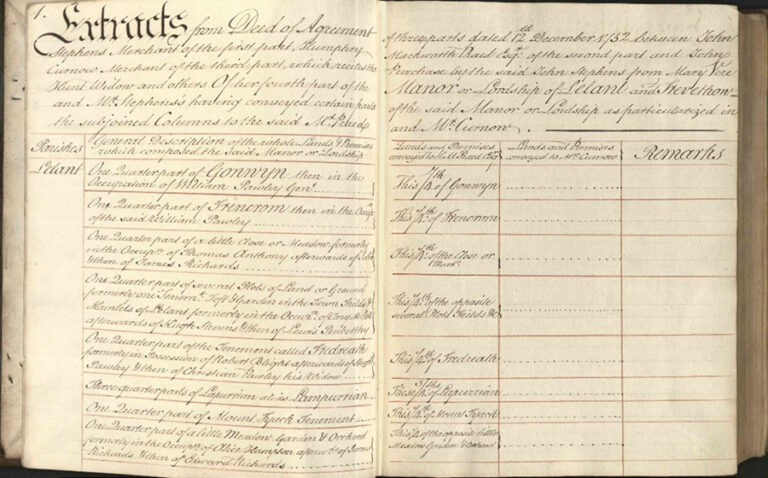
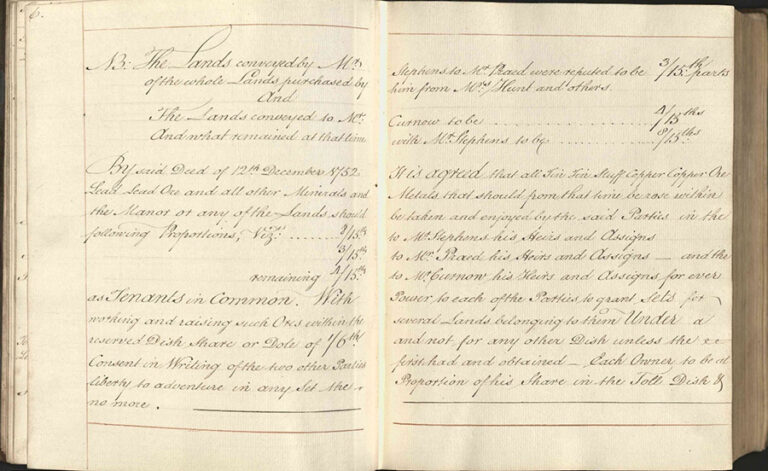
Manors and mining are intrinsically engrained into Cornish heritage and its past, but their stories are still very much relevant today. From mines hidden under the G7, to inspiring well-known authors, these records, dated from the 12th to the 20th centuries, often hold untapped sources of history that can provide insights into family history, finance, agriculture, environment, crime, property and land ownership. Records of Cornish tin can be found in medieval documents (often manorial), providing evidence that Cornwall probably has one of the longest histories of mining in the UK.
To learn more about the Cornwall Manorial Documents project, visit Manorial documents – Kresen Kernow.
To learn more about Cornwall Mine Exploration, visit Underground Caving and Mine Exploration Trips in Cornwall’s Tin Mines | Cornwall Underground Adventure.
I am trying to establish the identity of a mine shown on a hillside behind St Ives in a painting dating from mid-19th century and would appreciate the authors’ input. I do have some interesting images of Wheal Margery from an 1862 French article ‘Un Voyage aux mines du Cornouailles’ by Felix Durand-Brager if of interest.
I would be interested in those Wheal Margery (and why spelt Majory in this article) images. Am also interested in why Davies Giddy/Gilbert’s several mentions on the maps as landowning in these mining areas is not mentioned in the texts.
Really fascinating article and research. We are quick to forget what we can not see.